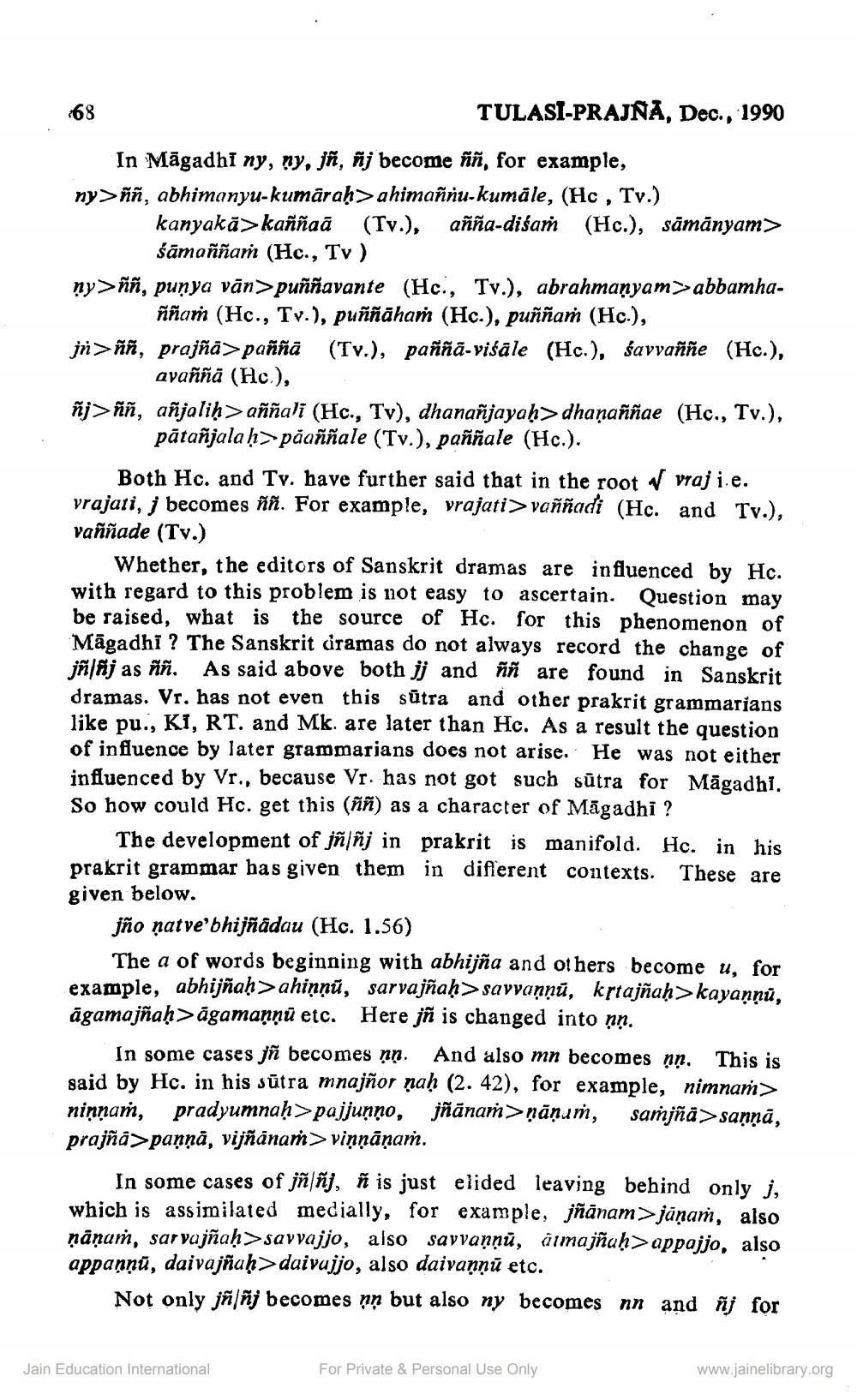________________
68
TULASI-PRAJNA, Dec., 1990
In Māgadhi ny, ny, jň, ñj become ññ, for example, ny>ññ, abhimanyu-kumāraḥ>ahimañnu-kumäle, (Hc , Tv.)
kanyakā>kaññaā (Tv.), añña-disaṁ (Hc.), sāmānyam>
śāmaññaṁ (Hc., Tv ) ny> ññ, punya vān>puññavante (Hc., Tv.), abrahmanyam> abbamha
ññam (Hc., Tv.), puññāham (Hc.), puññaṁ (Hc.), ji>ăã, prajña>pañña (Tv.), paññā- visale (Hc.), savvaññe (Hc.),
avaññā (Hc.), nj> ññ, añjaliņ> aññali (Hc., Tv), dhanañjayaḥ> dhaņaññae (Hc., Tv.),
pātañjalaḥ> păaññale (Tv.), paññale (Hc.). Both Hc. and Ty. have further said that in the root v vraj i.e. vrajati, į becomes ññ. For example, vrajati> vaññadi (Hc. and Tv.), vaññade (Tv.)
Whether, the editors of Sanskrit dramas are influenced by Hc. with regard to this problem is not easy to ascertain. Question may be raised, what is the source of Hc. for this phenomenon of Māgadhi ? The Sanskrit dramas do not always record the change of jñfijas ññ. As said above both jj and ññ are found in Sanskrit dramas. Vr. has not even this sūtra and other prakrit grammarians like pu., KI, RT. and Mk. are later than Hc. As a result the question of influence by later grammarians does not arise. He was not either influenced by Vr., because Vr. has not got such sūtra for Māgadhi. So how could Hc. get this (ññ) as a character of Māgadhi ?
The development of jñ ñj in prakritis manifold. Hc. in his prakrit grammar bas given them in different contexts. These are given below.
jño ñatve' bhijñādau (Hc. 1.56)
The a of words beginning with abhijña and others become u, for example, abhijñaḥ> ahiņņā, sarvajñaḥ> savvaạnú, krtajñaḥ>kayannü, āgamajñaḥ>āgamanņū etc. Here jñ is changed into nn.
In some cases jñ becomes nn. And also mn becomes ạn. This is said by Hc. in his sūtra mnajñor naḥ (2. 42), for example, nimnaṁ> niņņam, pradyumnaḥ>pajjuņņo, jñānaṁ>ņāņu, samjñā> sannā, prajñā>paņņā, vijñānaṁ> viņņāņaṁ.
In some cases of jñ ñj, ñ is just elided leaving behind only j, which is assimilated medially, for example, jñānam>jānań, also ņāņam, sarvajñaḥ>savvajjo, also savvaņņi, aimajñaḥ>appajjo, also appaņņū, daivajñaḥ> daivujjo, also daivannū etc.
Not only iñ ñj becomes nn but also ny becomes nn and ñj for
Jain Education International
For Private & Personal Use Only
www.jainelibrary.org




